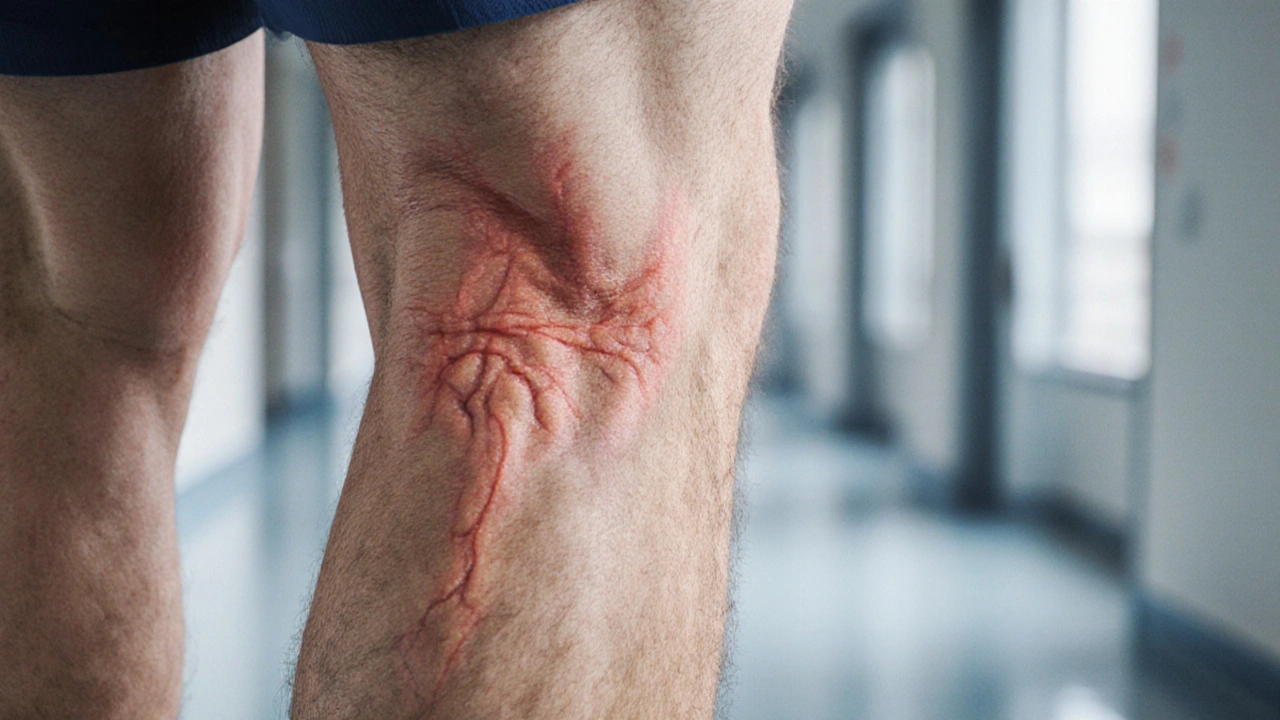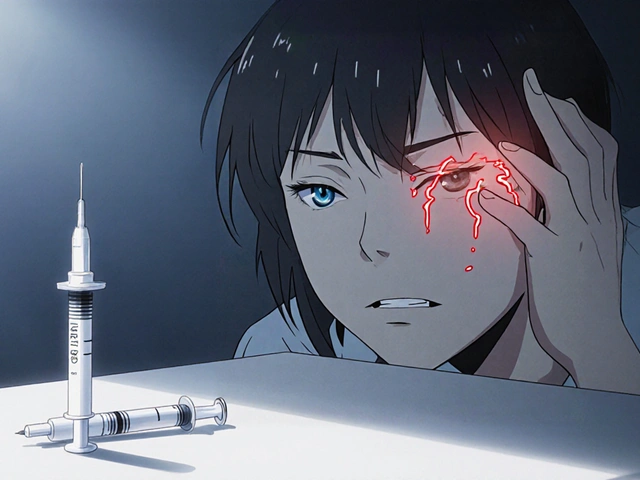Quick Take
- Acromegaly can double the chance of developing a deep‑vein clot compared with the general population.
- Elevated growth‑hormone (GH) and IGF‑1 levels make blood thicker and veins less flexible.
- Common warning signs include swelling, pain in the calf, sudden shortness of breath or chest pain.
- Regular screening, staying active, and managing GH excess cut the risk dramatically.
- If a clot does form, anticoagulant therapy and specialist monitoring are essential.
What is Acromegaly?
Acromegaly is a chronic endocrine disorder caused by a pituitary adenoma that secretes excess growth hormone. The hormone stimulates the liver to produce IGF‑1, which drives tissue growth. Most patients notice enlarged hands, facial features, and joint pain, but the disease also messes with metabolism, heart health, and blood vessels.
How Do Blood Clots Form?
Blood clots-or thromboses-arise when the coagulation cascade goes into overdrive. Three main factors, known as Virchow’s triad, fuel the process:
- Stagnant blood flow (often from prolonged sitting or reduced mobility).
- Damage to the vessel wall (trauma, inflammation, or atherosclerosis).
- Hypercoagulability (blood that’s more likely to clot).
When any two of these are present, a clot can form in the deep veins of the leg-called a deep‑vein thrombosis (DVT). If part of that clot breaks off, it may travel to the lungs, causing a pulmonary embolism (PE), a life‑threatening emergency.
Why Acromegaly Raises the Clotting Threat
Several mechanisms link acromegaly to a higher thrombosis rate:
- Elevated IGF‑1: IGF‑1 stimulates the production of fibrinogen and factor VII, both key clotting proteins.
- Visceral fat accumulation: Many acromegaly patients develop central obesity, which releases pro‑inflammatory cytokines that make blood stickier.
- Cardiovascular remodeling: Excess GH can thicken the arterial wall, narrowing vessels and slowing flow-perfect conditions for stasis.
- Sleep‑apnea: Common in acromegaly, it causes intermittent hypoxia, which increases platelet activation.
- Medication side‑effects: Some treatments (e.g., somatostatin analogues) may alter platelet function, though data are mixed.
In a 2023 European endocrine registry, the incidence of DVT in untreated acromegaly was 1.9% per year, versus 0.9% in age‑matched controls-almost a two‑fold jump.
Spotting the Warning Signs
Early detection saves lives. Keep an eye out for:
- Unexplained swelling or a feeling of heaviness in one leg.
- Sharp, cramping pain that worsens when you stand or walk.
- Red or discolored skin over the affected area.
- Sudden shortness of breath, rapid heartbeat, or chest tightness-possible PE symptoms.
- Persistent fatigue or unexplained bruising, which can hint at a clotting disorder.
If any of these appear, seek medical care right away. An ultrasound Doppler can confirm DVT within hours.

Prevention Strategies Tailored for Acromegaly
Reducing clot risk isn’t about a single magic bullet; it’s a combination of lifestyle tweaks, medical monitoring, and sometimes medication.
Control GH and IGF‑1 Levels
The cornerstone is normalising hormone excess. Options include:
- Surgical removal of the pituitary adenoma-first‑line for most patients.
- Somatostatin analogues (e.g., octreotide, lanreotide) to suppress GH secretion.
- GH receptor antagonists such as pegvisomant, which block IGF‑1 production.
When hormone levels drop into the target range, clot‑forming proteins typically decline as well.
Stay Physically Active
Even short walks break up venous stasis. Aim for 30 minutes of moderate activity most days-think brisk walking, cycling, or swimming. For office workers, stand up and stretch every hour.
Manage Weight and Metabolism
Weight loss of 5‑10% can lower fibrinogen levels by up to 15%. Pair a balanced diet (rich in omega‑3 fatty acids, fiber, and low‑glycemic carbs) with regular exercise.
Screen for Sleep‑Apnea
Polysomnography is recommended for anyone with enlarged tongue or facial bones-common in acromegaly. CPAP therapy not only improves sleep but also reduces platelet activation.
Consider Prophylactic Anticoagulation
High‑risk scenarios-major surgery, prolonged immobilisation, or a history of previous clot-may merit short‑term anticoagulants (low‑molecular‑weight heparin or direct oral anticoagulants). This decision should be made with an endocrinologist and a hematologist.
When a Clot Happens: Treatment Pathways
Prompt therapy cuts the chance of a clot traveling to the lungs.
- Anticoagulants: Heparin followed by warfarin or a DOAC (e.g., apixaban) for 3‑6 months, depending on recurrence risk.
- Thrombolytics: Used only for massive PE or limb‑threatening DVT; they dissolve clots quickly but carry bleeding risk.
- Compression stockings: Graduated stockings (15‑30mmHg) reduce post‑thrombotic syndrome and improve venous return.
- Follow‑up imaging: Repeat Doppler ultrasounds at 1 month and 3 months to ensure clot resolution.
Monitoring and Ongoing Care
Acromegaly is a lifelong condition; monitoring should be systematic.
| Visit | Key Tests | Purpose |
|---|---|---|
| Baseline (diagnosis) | IGF‑1, GH, CBC, fibrinogen, D‑dimer, leg ultrasound (if symptomatic) | Establish hormone control and clotting baseline |
| Every 6months | IGF‑1, GH, weight, blood pressure | Track disease activity and cardiovascular risk |
| Annually | Sleep study (if symptoms), D‑dimer | Detect hidden apnea or sub‑clinical clotting |
| Post‑surgery or medication change | Repeat IGF‑1, ultrasound if leg symptoms | Assess impact on clot risk |
Keeping a symptom diary-note any leg swelling, calf pain, or breathlessness-helps clinicians spot problems early.
Bottom Line
Living with acromegaly doesn’t mean you’re doomed to blood clots. By controlling hormone excess, staying active, managing weight, and staying vigilant for warning signs, you can keep the risk in check. Regular check‑ups and a partnership with your endocrine and vascular teams are the best defense.
Frequently Asked Questions
How much higher is the clot risk for someone with acromegaly?
Large registry studies show a roughly 1.8‑ to 2‑fold increase in deep‑vein thrombosis compared with the general population, especially when IGF‑1 remains uncontrolled.
Can the medications used to treat acromegaly cause clots?
Most treatments actually lower clot risk by reducing GH and IGF‑1. A few somatostatin analogues have been linked to modest changes in platelet function, but the overall effect is protective when hormone levels are normalised.
Should I take blood‑thinners as a preventive measure?
Routine prophylactic anticoagulation isn’t recommended for all acromegaly patients. It’s reserved for high‑risk situations-recent surgery, long‑haul travel, or a prior clot-after a risk‑benefit discussion with your doctor.
What lifestyle changes matter most?
Regular aerobic exercise, weight management, and treating sleep‑apnea have the biggest impact on reducing clot‑forming proteins and improving blood flow.
How is a suspected DVT diagnosed quickly?
A bedside duplex ultrasound is the gold‑standard test. It can visualise clot location and determine whether immediate anticoagulation is needed.




Bryce Charette
September 28, 2025 AT 14:17Living with acromegaly definitely adds a layer of complexity to everyday health decisions, especially when it comes to blood clot risk. The hormone excess you mentioned drives up fibrinogen and factor VII, which means the blood becomes more prone to coagulate. Because of that, staying active isn’t just a recommendation-it’s a preventive measure that can literally keep the veins flowing smoothly. Even short walks break up the stagnation that Virchow’s triad warns about. Regular monitoring of IGF‑1 levels gives a clear picture of whether the biochemical environment is still pro‑thrombotic. If the numbers are trending down, you’ll often see a corresponding dip in clot‑forming proteins. Weight management plays a similar role; shedding a modest 5‑10 % can lower fibrinogen by up to 15 %. Also, untreated sleep apnea injects intermittent hypoxia that spikes platelet activation, so a CPAP machine can be a silent hero in this scenario. For those on somatostatin analogues, keeping an eye on platelet function isn’t a bad idea, even though the overall trend is protective. When a surgery or a long flight looms, short‑term prophylactic anticoagulation can be discussed with your care team to bridge the high‑risk window. In practice, a simple daily habit-standing up and stretching every hour at work-can make a measurable difference. Compression stockings may feel old‑fashioned, but they truly reduce post‑thrombotic syndrome after a DVT event. If you ever notice swelling, calf pain, or a sudden breathlessness, an urgent duplex ultrasound can confirm a clot within hours. Early detection allows for prompt anticoagulation, which dramatically cuts the chance of a pulmonary embolism. Keeping a symptom diary, as suggested, helps both you and your doctors spot patterns before they become emergencies. Partnering with an endocrinologist and a hematologist builds a safety net that catches issues early. Ultimately, proactive lifestyle tweaks combined with vigilant medical follow‑up turn a daunting risk into a manageable one.
Christina Burkhardt
October 7, 2025 AT 09:25One practical tip is to incorporate omega‑3 rich foods like salmon or flaxseeds into your meals, as they have mild antiplatelet effects that complement medical therapy. Also, using a standing desk can reduce the sedentary periods that contribute to venous stasis. Remember to hydrate well; dehydration can thicken the blood and exacerbate clot risk. If you’re scheduled for any major surgery, discuss a brief course of low‑molecular‑weight heparin with your surgeon. Consistency with medication adherence, especially after pituitary surgery, keeps IGF‑1 in the target range and lowers clotting factors. Finally, keep your follow‑up appointments-regular labs are the best way to catch any rebound in hormone levels early. :)
Ria Ayu
October 16, 2025 AT 04:33It’s fascinating how the body’s endocrine and vascular systems intertwine, isn’t it? When GH and IGF‑1 are out of balance, the cascade doesn’t just affect bone growth; it subtly reshapes the circulatory environment. This reminds me of the ancient concept that health is a harmonious orchestra of many instruments. In this case, clarity comes from listening to the signals your labs send you. A steady rhythm of exercise, proper sleep, and hormone control can create a symphony that reduces clot risk. Keep an eye on your personal data, and let it guide you toward the most harmonious lifestyle.
Sharon Lax
October 24, 2025 AT 23:40While the overview is thorough, the emphasis on “regular screening” could be more precise-what specific biomarkers or imaging modalities should be prioritized? In clinical practice, a baseline Doppler ultrasound combined with fibrinogen quantification offers a pragmatic approach. Also, mentioning “some treatments may alter platelet function” without citing data leaves a vague impression; a brief reference to the relevant studies would substantiate the claim. Overall, the piece could benefit from tighter integration of evidence‑based guidelines.
paulette pyla
November 2, 2025 AT 17:48Oh sure, let’s all just trust the “American” healthcare system to magically fix everything without any personal responsibility. Maybe if you’d actually move to a country with real preventive care, you wouldn’t need all these “tips.” But hey, keep posting those generic lists, they’re totally original. 🙄
Benjamin Cook
November 11, 2025 AT 12:56Hey guys!! Just wanted to shout out that staying active is key!!! Even a 10‑minute walk every couple of hours can do wonders for your veins!!! Don’t forget to drink plenty of water-dehydration can make blood super sticky!! And if you’re on any meds, double‑check with your doc that they’re not messing with your platelets!! Keep that momentum going, you got this!!
karthik rao
November 20, 2025 AT 08:04It is imperative to acknowledge that the pathophysiology of acromegaly‑associated thrombosis is underpinned by a complex interplay of hematologic and metabolic perturbations. Consequently, a multidisciplinary approach-encompassing endocrinology, hematology, and vascular medicine-should be advocated. 📊 Moreover, rigorous adherence to therapeutic regimens, coupled with periodic re‑evaluation of coagulation profiles, constitutes best practice. Failure to do so may culminate in avoidable morbidity, a scenario best circumvented through diligent care coordination.
Breanne McNitt
November 29, 2025 AT 03:12Totally agree with the point about regular exercise! I’ve found that joining a community walking group not only keeps me moving but also adds a social boost. Plus, swapping processed snacks for fresh fruits and nuts has helped me keep my weight in check, which is another win‑win for clot prevention. Let’s keep sharing these practical hacks!
Ashika Amirta varsha Balasubramanian
December 7, 2025 AT 22:20From a cultural perspective, many South Asian diets are rich in spices like turmeric and ginger, both of which have anti‑inflammatory properties that may indirectly support healthier blood flow. Incorporating these into daily meals, alongside leg‑raising yoga poses, can be both enjoyable and beneficial. Also, be mindful of traditional sweets that are high in sugar; excessive glucose can exacerbate hypercoagulability. A balanced approach that respects cultural foods while managing portion sizes offers a sustainable pathway to lower clot risk.
Jacqueline von Zwehl
December 16, 2025 AT 17:28I appreciate the comprehensive breakdown and would just add that keeping a personal log of any leg discomfort can help your clinicians spot trends early. Even a brief note in a phone app can make a difference during follow‑up visits.